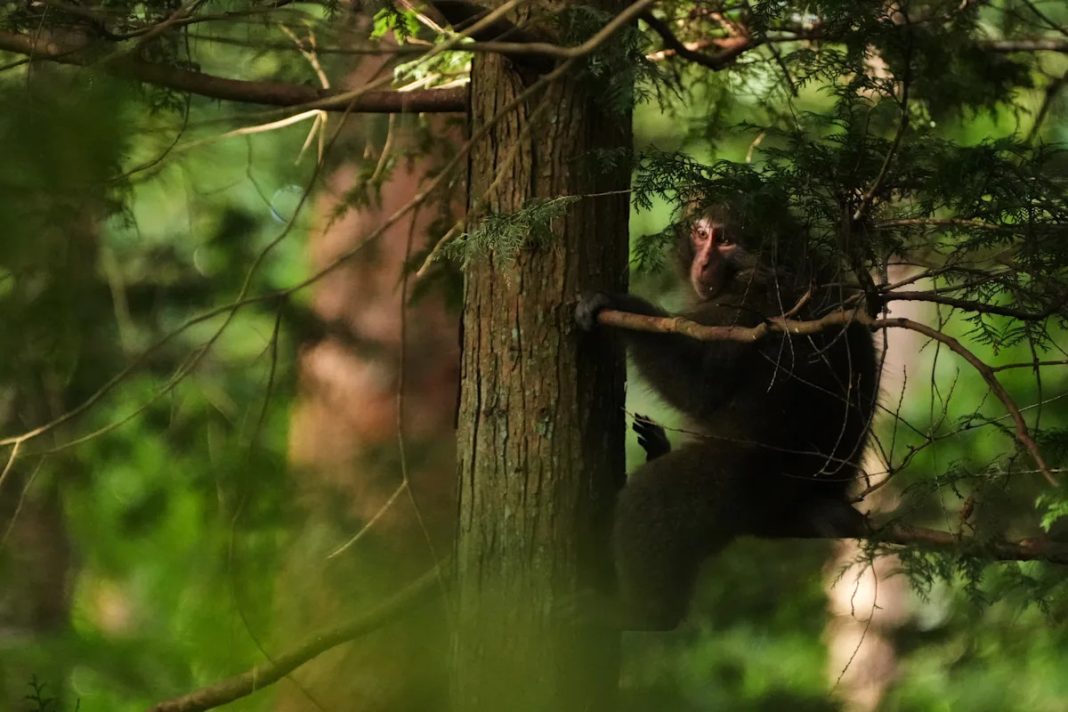AZUMINO, Japan (AP) — In the foothills of Japan’s Northern Alps, people are chasing monkeys.
Wearing bright orange vests, the humans ring bells, blow whistles and strike rocks and trees with walking sticks as they weave through bamboo and brush. Using GPS trackers, they follow the monkeys’ movements and radio teammates to close in when nearby. The aim is to herd the animals back into the mountains and away from farms and homes.
About 90 kilometers (55 miles) to the south, Jigokudani Monkey Park attracts more than 200,000 visitors a year — half of them from overseas — who come to see the same species soak in the hot springs.
Beloved by tourists, Japanese macaques are hated by many locals.
The monetary damage they cause is relatively minor, compared to losses from boar, deer and crows. But the monkeys are increasingly a bother for people on farms and in neighborhoods near the mountains, breaking into homes, stealing food and ruining crops.
In 2022, Japan’s Agriculture Ministry reported total crop damage from wild animals, including monkeys, at 15.6 billion yen ($100 million), with deer, wild boars and macaques causing about 70% of that damage.
Enter the Monkey Chasing Squad, about 50 paid, part-time civil servants who try to control the monkeys.
Before 2023, nearly all the monkeys in Ariake, a district of Azumino city, lived within the town, with only 1% in the mountains, said Masaya Miyake, who moved to Azumino five years ago and now leads the squad. According to the city, the macaques spend about half their time in the hills and the remainder in the villages, an improvement both Miyake and the city attribute to the group’s efforts.
“We’re just returning them to where they’re supposed to be,” said Miyake. “Naturally, the food in the village is more nutritious and tastier. They’re not simply being mischievous; they’re just coming down to eat.”
Searching for the right method to control monkeys
Takumi Matsuda had his first experience with monkeys when they broke into his home, after he moved to Azumino with his father 10 years ago.
He now rises early to observe the monkeys, and his posts on Instagram have gained more than 60,000 followers. His photos and videos show the monkeys not as pests or pets but as wild animals.
“I want to share with as many people as possible the peaceful behavior of monkeys in their natural habitat,” he told The Associated Press.
One winter morning deep in the mountains, Matsuda encountered a hunter authorized to cull monkeys, which Azumino estimates at a population of about 600 in the city. Capturing monkeys is done by hunting organizations with the government’s permission.
“When I asked why he killed that specific monkey, he told me it was simply because he had seen it,” Matsuda said.
“He hadn’t considered whether the monkey was from a group that encroached on human settlements and actually destroyed fields or attacked humans at random, or one that stayed deep in the forest.”
That made Matsuda question the city’s approach. “In Japan today, opinions have become polarized between ‘don’t kill a single one’ and ‘kill them all,’” he said. “I oppose the wasteful taking of life and want effective measures so we don’t have to keep killing monkeys forever.”
‘Culling could make the problem worse’
The Monkey Chasing Squad patrols the hills year-round. Despite the group’s efforts to keep the monkeys away from human settlements, calls to cull large numbers of monkeys are growing.
“A quick, painless death by someone skilled is the last kindness we can offer,” said Azumino City Councilman Yoichi Tsujitani. He estimates it would take two to three years to remove macaques entirely from areas near humans.
But efforts to cull macaques may have made the problem worse, according to ecologist Shigeyuki Izumiyama of Nagano’s Shinshu University. When entire troops are removed, neighboring groups move in, and shrinking troop sizes push surviving monkeys deeper into farmland.
“Part of the issue is that legislators don’t have enough time and are being asked to produce quick results,” said Takayo Soma, a primate researcher at Kyoto University. “But ecology doesn’t work that way. Macaques live about 20 years, so we need to take a long-term approach.”
More clashes between humans and monkeys are likely
Michael Johnson, a retired English professor who has lived in Azumino since 2011, said that monkeys have broken into his house four times. A 2021 raid by 12 monkeys resulted in a five-hour cleanup after they feasted on eggs, bread, grains, fruit and almost everything else in sight.
“They didn’t get into the bourbon,” Johnson joked.
“I stopped going to City Hall,” he said, referring to local efforts to deal with the monkeys with free rocket fireworks and one-month air gun rentals. “What’s the point? I think my slingshot is better, though they’re smart enough to stay out of range.”
The species was granted protective status in 1947 to rebuild its population after widespread killing during World War II.
Izumiyama, the Shinshu University professor, advocates clearing vegetation near farms, pinpointing the location of monkeys with GPS collars using an antenna and smartphone decibel meter, as the monkey chasers do, and installing electric fences.
Kazuo Matsuda, an apple farmer who installed electric fences on his property, said the fences keep monkeys from coming down the mountain and into his orchard but are expensive to maintain.
Retired teacher Shigeru Maruyama, a member of the Monkey Chase Squad who also grows apples and blueberries, said dogs are better than people at chasing them away.
“When people chase them, the monkeys just taunt us, like ’Come on, try me,’” said Takahiro Isomoto, who has trained dogs to ward off monkeys, bears, boars and deer.
At a forest shrine, Miyaki’s squad took a short break. Within minutes of being chased away, the monkeys returned to the shrine roof to watch the humans below.
“Now it’s almost the opposite — like we’re the squad that doesn’t chase monkeys,” the squad leader quipped.

